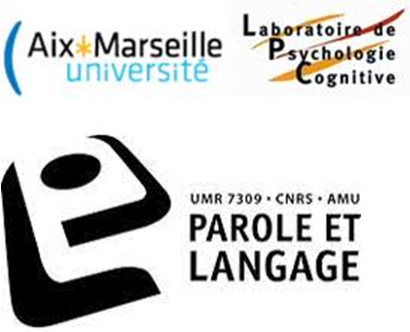JOURNEE ILCB
Vendredi 11 mars 2022 de 9h30 à 17h à Marseille, Campus St-Charles, 3 place Victor Hugo, Grand amphi

PROGRAMME:
9h30 Conférence Plénière Ghislaine DEHAENE-LAMBERTZ, Directrice de Recherche CNRS,Cognitive Neuroimaging Unit, CEA, Paris

“Are human infants able to use symbols?”
Summary :
Human adults commonly use symbolic systems (e.g. speech, numbers, writing code, algebraic formula) to represent aspects of the external world, and they easily and flexibly go from symbols to objects and vice-versa. This “symbolic mind” might be related to a distinct human neural architecture, in particular, the expansion of the associative areas and the development of new long-distance fiber tracts, such as the arcuate fasciculus. More efficient connections to and from the frontal lobe and a longer memory buffer may lead to the discovery of more abstract structures, and ultimately enable to represent the external world with a symbolic system.
This neural architecture is in place at full-term birth and brain imaging studies have revealed that higher-level associative regions, such as frontal areas, are involved in infant’s cognition from start. We may thus expect that infants might share the same symbolic competence than adults. To support this claim, I will present brain imaging data showing the infants’ structural and functional brain architecture but also behavioral and ERP data revealing symbolic and logical computation in young infants.
—————–
10h30 Soutenance HDR, Kristof STRIJKERS, Chargé de Recherche CNRS, Laboratoire Parole et Langage, Aix-en-Pr.

“Towards an Integrated Brain Language Model — The spatiotemporal dynamics of production versus perception”
Committee :
- Sonja KOTZ, Maastricht University (rapporteure)
- Benjamin MORILLON, Aix-Marseille Université (rapporteur)
- Noël NGUYEN, Aix-Marseille Université (tuteur)
- Martin PICKERING, Edinburgh University (rapporteur)
- Rasha ABDEL RAHMAN, Humboldt-Universität zu Berlin (examinatrice)
Summary :
The capacity of communicating through language has been instrumental in the evolution of our species. Being able to quickly alert our peers of an upcoming danger has high biological relevance, and the ease and speed with which we can use language has made this our primary communicative tool. Not surprisingly, understanding the fundaments of this ability has been a central issue throughout the history of human and social sciences. By now, our knowledge about the representations and processes underpinning language behaviour is impressive and thanks to the combined efforts of linguists, psychologists and neuroscientists, detailed neurolinguistic models of language production and perception have been developed. Despite the huge advances made to understand this complex capacity of the human mind, language research has been typically modality-specific, with a dissociation between production and comprehension in terms of research strategies, paradigms and models. The objective of the research I present here for my HDR project is to explore the nature of linguistic representations and processes from an integrated perspective. This is important, because in order to fully understand language processing and develop a neurolinguistic model that explains behavior, we’ll need to understand how production and perception interact. This HDR aims at contributing to this endeavor by comparing the spatiotemporal dynamics of production and perception for the basic building blocks of language: words. In doing so, I want to address the question of whether and how word representations and their processing overlap in time and space in the speaker and listener’s minds.
—————–
13h BUFFET ILCB
—————–
14h30 Soutenance HDR Adrien MEGUERDITCHIAN, Chargé de recherche CNRS, Laboratoire de Psychologie Cognitive, Marseille

“On the gestural origins of language : What baboons’ gestures and brain asymmetry could tell us”
Committee :
- Pascal BELIN, Institut de Neurosciences de la Timone, CNRS, Aix-Marseille Univ (rapporteur)
- Emmanuel MELLET, Institut des Maladies Neurodégénératives, CEA, CNRS, Bordeaux Univ (rapporteur)
- Martine MEUNIER, Centre de Recherche en Neurosciences de Lyon, INSERM, CNRS (rapporteuse)
- Ghislaine DEHAENE-LAMBERTZ, Neuroimagerie Cognitive, INSERM, CEA, Univ Paris-Saclay (examinatrice)
- Marieke LONGCAMP, Laboratoire de Neuroscience Cognitive, CNRS, Aix-Marseille Univ (tutrice)
- Jacques VAUCLAIR, Centre PsyCLE, Aix-Marseille Univ (invité)
Summary :
Nonhuman primates mostly communicate not only with a rich vocal repertoire but also with manual and body gestures. In contrast to great apes, this latter communicative gestural system has been poorly investigated in monkeys. In the last 15 years, the gestural research we conducted in the baboons Papio anubis, an Old World monkey species, have shown potential direct evolutionary continuities with some key properties of language such as intentionality, referentiality, learning flexibility as well as its underlying lateralization and hemispheric specialization of the brain. According to these collective findings, which are congruent with the ones reported in great apes, it is thus not excluded that features of gestural communication shared between humans, great apes and baboons, may have played a critical role in the phylogenetic roots of language and dated back, not to the Hominidae evolution, but rather to their much older Catarrhine common ancestor 25-40 million years ago.
—————–
17h APERO
